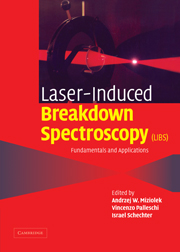Book contents
- Frontmatter
- Contents
- List of contributors
- Preface
- 1 History and fundamentals of LIBS
- 2 Plasma morphology
- 3 From sample to signal in laser-induced breakdown spectroscopy: a complex route to quantitative analysis
- 4 Laser-induced breakdown in gases: experiments and simulation
- 5 Analysis of aerosols by LIBS
- 6 Chemical imaging of surfaces using LIBS
- 7 Biomedical applications of LIBS
- 8 LIBS for the analysis of pharmaceutical materials
- 9 Cultural heritage applications of LIBS
- 10 Civilian and military environmental contamination studies using LIBS
- 11 Industrial applications of LIBS
- 12 Resonance-enhanced LIBS
- 13 Short-pulse LIBS: fundamentals and applications
- 14 High-speed, high-resolution LIBS using diode-pumped solid-state lasers
- 15 Laser-induced breakdown spectroscopy using sequential laser pulses
- 16 Micro LIBS technique
- 17 New spectral detectors for LIBS
- 18 Spark-induced breakdown spectroscopy: a description of an electrically generated LIBS-like process for elemental analysis of airborne particulates and solid samples
- Index
- References
15 - Laser-induced breakdown spectroscopy using sequential laser pulses
Published online by Cambridge University Press: 08 August 2009
- Frontmatter
- Contents
- List of contributors
- Preface
- 1 History and fundamentals of LIBS
- 2 Plasma morphology
- 3 From sample to signal in laser-induced breakdown spectroscopy: a complex route to quantitative analysis
- 4 Laser-induced breakdown in gases: experiments and simulation
- 5 Analysis of aerosols by LIBS
- 6 Chemical imaging of surfaces using LIBS
- 7 Biomedical applications of LIBS
- 8 LIBS for the analysis of pharmaceutical materials
- 9 Cultural heritage applications of LIBS
- 10 Civilian and military environmental contamination studies using LIBS
- 11 Industrial applications of LIBS
- 12 Resonance-enhanced LIBS
- 13 Short-pulse LIBS: fundamentals and applications
- 14 High-speed, high-resolution LIBS using diode-pumped solid-state lasers
- 15 Laser-induced breakdown spectroscopy using sequential laser pulses
- 16 Micro LIBS technique
- 17 New spectral detectors for LIBS
- 18 Spark-induced breakdown spectroscopy: a description of an electrically generated LIBS-like process for elemental analysis of airborne particulates and solid samples
- Index
- References
Summary
Introduction
In laser-induced breakdown spectroscopy (LIBS), first reported by Brech and Cross in 1962 [1], a laser is used to ablate and atomize material from a sample and to form a plasma. Emission from the plasma is used to identify and quantify elements within the sample. The ability to form a plasma on unprepared samples makes LIBS an amazingly versatile analytical technique. It is one of the few techniques that can be used for non-contact elemental analysis, making LIBS uniquely suited to measurements of hazardous materials and materials in difficult-to-reach locations [2–16]. The sampling is virtually non-destructive, making LIBS useful for such unique applications as the analysis of priceless works of art and archeological relics [17–21]. Other applications that benefit from the unique advantages of LIBS include environmental [22–28], industrial [2–4, 23, 24, 29–36], geological [22, 25–27], planetary [22], art [28–42], medical [43, 44], and dental [45] measurements. Recently, many researchers have coupled LIBS with other techniques such as ICP-MS[12, 41, 42, 46–48].
Despite the increasing popularity of LIBS, the sensitivity and precision of the technique are relatively poor compared with other forms of atomic spectroscopy and there are significant matrix effects and relatively high background signals [49]. There are also many fundamental studies aimed at improving the sensitivity and precision of LIBS[34, 50–54]. These studies have led to investigations of multiple-pulse LIBS, which can give greatly enhanced emission signals and improved signal to background ratio [55–58].
- Type
- Chapter
- Information
- Laser Induced Breakdown Spectroscopy , pp. 516 - 538Publisher: Cambridge University PressPrint publication year: 2006
References
- 2
- Cited by



